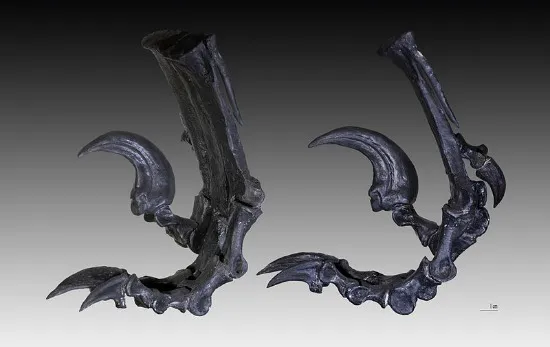How Did Raptors Use Their Fearsome Toe Claws?
Claw Shapes: A Glimpse Into the Lifestyle of Raptors?
/https://tf-cmsv2-smithsonianmag-media.s3.amazonaws.com/filer/20121207013045deinonychus-small.jpg)
When paleontologist John Ostrom named Deinonychus in 1969, he provided the spark for our long-running fascination with the “raptors.” Similar dinosaurs had been named before–Velociraptor and Dromaeosaurus were named four decades earlier–but the skeleton of Ostrom’s animal preserved a frightening aspect of the dinosaur that had not yet been seen among the earlier finds. The assembled remains of Deinonychus included the dinosaur’s eponymous “terrible claw”–a wicked, recurved weapon held off the ground on the animal’s hyperextendable second toe. Combined with the rest of the dinosaur’s anatomy, Ostrom argued, the frightening claw indicated that Deinonychus must have been a active, athletic predator.
But how did Deinonychus and its similarly-equipped relatives use that awful toe claw? The appendage looks fearsome, but paleontologists have not been able to agree on whether the claw was using for slashing, gripping, pinning, or even climbing prey. Some researchers, such as Phil Manning and collaborators, have even argued that the claws of Velociraptor and related dinosaurs were best suited to scaling tree trunks–a conclusion consistent with the contentious hypothesis that the ancestors of birds were tree-climbing dinosaurs.

All this assumes that the claws of deinonychosaurs correspond to a special behavior, but can foot claw shapes really give away the habits of dinosaurs? That’s the question posed by a new PLoS One study by zoologist Aleksandra Birn-Jeffery and colleagues.
Based on observations of living animals, researchers have often tied particular claw shapes to certain behaviors–relatively straight, stubby claws likely belong to an animal that runs on the ground, while tree-climbing species have thin claws with small, sharp points. But nature isn’t quite so neat as to have a single, tell-tale claw shape for perchers, ground-runners, climbers, and predators. Even then, researchers don’t always interpret claw shapes the same way–depending on who you ask, the foot claws of the early bird Archaeopteryx either indicate that it was a climber or could only run on the ground.
To parse this problem, Birn-Jeffery and co-authors studied the geometry of the third toe claw–on dinosaurs, the middle toe claw–in 832 specimens of 331 species, together representing different lifestyles of birds, lizards, and extinct dinosaurs. The claw shapes didn’t strictly conform to particular behaviors. In the climber category, for example, the frill-necked lizard has lower claw curvature than expected, and, among predatory birds, the common buzzard, secretary bird, and greater sooty owl has less sharply recurved claws that anticipated for their lifestyle.
When the dinosaur data was dropped into the mix, the deinonychosaurs didn’t seem to fit in any single category. The sickle-clawed carnivores fell into the range shared by climbers, perchers, predators, and ground dwellers–these dinosaurs could be said to be anything from wholly terrestrial runners to perchers. And even though the researchers identified a general claw shape that corresponded to walking on the ground–deeper claws with less curvature–the dinosaurs did not strictly fit into this category alone.
Some dinosaurs, such as Microraptor, had claws that might have been suited to climbing. However, dinosaurs that we might regard as behaviorally similar showed differences–Velociraptor seemed to best fit the ground-dweller category, while the larger Deinonychus seemed to have claws more akin to those of predatory birds. This doesn’t mean that Microraptor was definitely a climber, or that Velociraptor wasn’t a predator. As the authors show, the different behavioral categories are not so easily distinguishable as previously thought, and saying that an animal definitely engaged in a particular behavior because of claw shape alone tempts oversimplification.
No wonder there has been such a range of interpretation about dinosaur foot claws! While the new study focused on the third toe claw rather than the famous, second deinonychosaur toe claw, the point of the analysis still applies. Claw geometry alone is not a reliable indicator of behavior. That’s to be expected–as the authors point out, claws are multi-functional, are are unlikely to represent just one type of behavior or habitat. Birds that use their claws to perch may also use them to kill prey, or birds that primarily live in the trees may also forage on the ground. Claw shape is constrained by different aspects of natural history, and reflect flexibility rather than strict adherence to a particular lifestyle. Deinonychosaur claws definitely hold clues to the natural history of dinosaurs, but drawing out those clues is a difficult, convoluted process.
Reference:
Birn-Jeffery, A., Miller, C., Naish, D., Rayfield, E., Hone, D. 2012. Pedal Claw Curvature in Birds, Lizards and Mesozoic Dinosaurs – Complicated Categories and Compensating for Mass-Specific and Phylogenetic Control. PLoS ONE. 7,12: e50555. doi:10.1371/journal.pone.0050555
/https://tf-cmsv2-smithsonianmag-media.s3.amazonaws.com/accounts/headshot/RileyBlack.png)
/https://tf-cmsv2-smithsonianmag-media.s3.amazonaws.com/accounts/headshot/RileyBlack.png)